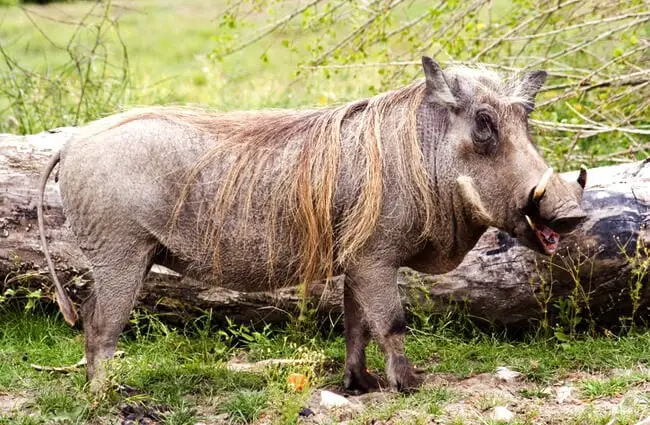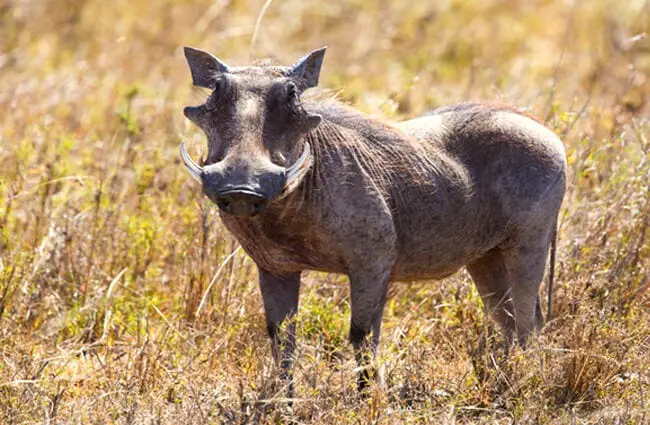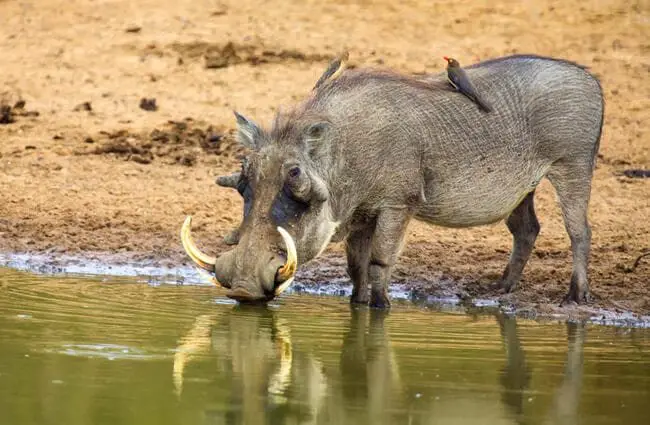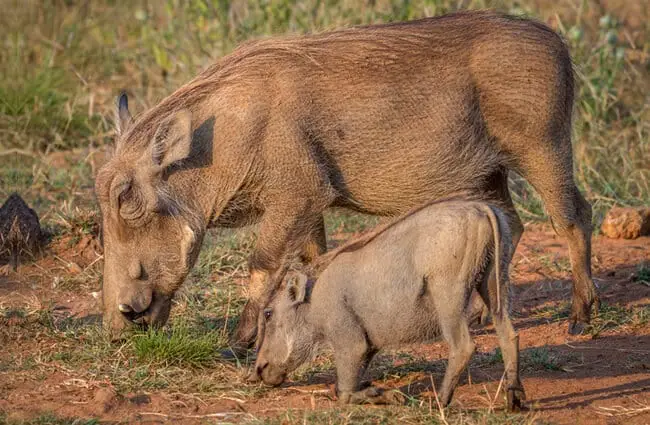The Warthog: Africa’s Endearing, Tusked Gardener
Often misunderstood and sometimes underestimated, the warthog (Phacochoerus africanus) is far more than just a quirky face of the African savanna. This iconic wild pig, with its distinctive facial warts and impressive tusks, plays a vital role in its ecosystem and boasts a fascinating life story. From its evolutionary roots to its complex social behaviors, the warthog offers a captivating study for anyone interested in the wild heart of Africa.
Unmistakable Appearance: What Makes a Warthog a Warthog?
Warthogs are instantly recognizable. Their name comes from the large, wart-like protuberances on their faces, which are actually thick skin and cartilage, more prominent on males. These “warts” serve as protective padding during fights. They possess a large head, a sparse coat of bristly hair, and a distinctive mane running down their spine. Perhaps their most striking features are their formidable tusks: two pairs of continuously growing canine teeth. The upper tusks curve upwards and outwards, while the shorter lower tusks are razor-sharp, honed against the upper pair. An adult warthog typically stands between 63 to 85 cm (25 to 33 inches) at the shoulder and can weigh from 50 to 150 kg (110 to 330 lbs), with males generally larger than females.

Where the Wild Warthogs Roam: Habitat and Distribution
Warthogs are quintessential inhabitants of sub-Saharan Africa. Their preferred habitats are open grasslands, savannas, and woodlands, where they can graze on grasses and roots, and find readily available water sources. They are particularly fond of areas with scattered trees and shrubs, which offer both food and cover. While they thrive in arid and semi-arid regions, they are dependent on water and will not be found in true deserts or dense rainforests. Their range extends across much of eastern, central, and southern Africa, making them a common sight on safari. They are adaptable creatures, capable of surviving in a variety of environments as long as their basic needs for food, water, and shelter are met.

The Warthog’s Menu: A Foraging Lifestyle
Warthogs are primarily herbivores, with a diet consisting mainly of grasses, roots, and tubers. They are expert diggers, using their tough snouts and tusks to unearth underground plant parts, often kneeling on their calloused front knees to graze or dig more efficiently. This unique foraging posture is a hallmark of the species. While grasses form the bulk of their diet, especially during the wet season, they are opportunistic feeders. During drier periods, they will consume bulbs, rhizomes, fruits, and even bark. Occasionally, they may supplement their diet with insects, small carrion, or even bird eggs, demonstrating a degree of omnivory, though this is not their primary food source. Their digging activities play a crucial role in aerating soil and dispersing seeds, contributing significantly to the health of their ecosystem.

Social Dynamics and Daily Life
Warthogs exhibit interesting social structures. Females (sows) typically live in sounders, which are small family groups consisting of a mother and her offspring, sometimes joined by other related females. Males (boars) are often solitary, though they may form bachelor groups outside of the breeding season. Warthogs are diurnal, meaning they are most active during the day, spending their time foraging, wallowing in mud to cool down and deter parasites, and resting. At night, they retreat into burrows to escape predators and the elements. They do not dig their own burrows but instead modify abandoned aardvark holes or natural crevices, often backing in headfirst to present their formidable tusks to any potential intruder.
The Cycle of Life: Mating and Reproduction
Warthog reproduction is a fascinating process, typically occurring seasonally. The breeding season is often tied to rainfall patterns, ensuring that piglets are born when food resources are abundant. During this time, solitary boars will seek out sounders, and fierce competition can ensue between males for mating rights. These battles involve head-to-head pushing and tusk-wrestling, with the facial warts providing some protection. After a gestation period of approximately 160 days, a sow will give birth to a litter of 1 to 8 piglets, though 2 to 4 is most common. Piglets are born in a secluded burrow, where they remain for several weeks, protected by their mother. They are precocial, meaning they are relatively mature and mobile at birth, but entirely dependent on their mother’s milk and protection. Weaning occurs around 3-4 months, but piglets will stay with their mother for up to a year or more, learning essential survival skills. The strong maternal bond is crucial for the survival of the young.

A Glimpse into the Past: Warthog Evolution
The evolutionary history of warthogs is deeply rooted in the African continent. They belong to the family Suidae, which includes pigs, hogs, and boars worldwide. Fossil evidence suggests that the genus Phacochoerus emerged in Africa during the Pliocene epoch, approximately 5 million years ago. Early warthog ancestors likely evolved from more generalized pig-like forms, adapting to the expanding savannas and grasslands of Africa. The development of their distinctive facial warts and specialized tusks are adaptations for defense against predators and for efficient foraging in their open habitats. The common warthog (Phacochoerus africanus) is one of two extant species, the other being the desert warthog (Phacochoerus aethiopicus), which was once thought to be a subspecies. Genetic studies have helped clarify their distinct evolutionary paths, highlighting the incredible biodiversity within the Suidae family.
Ecosystem Engineers: Warthogs and Their Interactions
Warthogs are more than just grazers, they are active participants in their ecosystem, often referred to as “ecosystem engineers” due to their digging habits. Their constant rooting aerates the soil, aids in water penetration, and helps distribute seeds, fostering plant growth. This activity also unearths invertebrates, providing food for birds like oxpeckers, which often ride on the warthogs’ backs, feeding on ticks and other parasites. This symbiotic relationship benefits both species. Warthogs are also a significant prey item for large African predators, including lions, leopards, cheetahs, hyenas, and even crocodiles, playing a crucial role in the food web. Their presence supports a diverse array of carnivores, maintaining the delicate balance of the savanna ecosystem.

Warthogs and Humans: Culture, Interaction, and Conservation
The warthog’s distinctive appearance has earned it a place in human culture, most notably as the beloved character Pumbaa in Disney’s “The Lion King,” which introduced the species to a global audience with a positive, if somewhat anthropomorphized, portrayal. In many African cultures, warthogs are viewed with a mix of respect for their resilience and sometimes as a nuisance due to their tendency to raid crops. Historically, they have been hunted for their meat and tusks, though regulated hunting is now often part of conservation strategies in some areas.
Interaction with humans in the wild is generally infrequent and non-confrontational. Warthogs are typically shy and will flee at the first sign of danger, often running with their tails held high like antennae. However, like any wild animal, they can be dangerous if cornered or if a sow perceives her piglets to be threatened. Their sharp lower tusks are formidable weapons. Conservation status for the common warthog is currently “Least Concern” by the IUCN, thanks to their wide distribution and adaptability. However, local populations can face threats from habitat loss, agricultural expansion, and unregulated hunting. Protected areas and national parks are vital for ensuring their continued survival.
Encountering Warthogs in the Wild: A Hiker’s Guide
For those venturing into African savannas, encountering a warthog can be a memorable experience. Here is what to know:
- Where to Look: Open grasslands, savannas, and waterholes are prime locations. They are diurnal, so look for them during the day.
- How to Spot Them: Look for their distinctive “kneeling” posture while grazing or their tails held high as they run.
- What to Do if You See One:
- Maintain Distance: Always keep a respectful and safe distance.
- Observe Quietly: Avoid sudden movements or loud noises.
- Never Approach: Especially a sow with piglets.
- If They Feel Threatened: A warthog might snort, stamp its feet, or even charge as a warning. If this happens, slowly back away without turning your back or running. Their primary defense is usually flight into a burrow.
Caring for Warthogs in Captivity: A Zookeeper’s Perspective
Zookeepers play a crucial role in educating the public and contributing to conservation efforts for species like the warthog. Caring for them requires specific considerations:
- Habitat Design:
- Spacious Enclosures: Mimic natural savanna environments with open areas for grazing and digging.
- Substrate: Provide soft, diggable soil or sand to allow for natural rooting behaviors.
- Shelter: Offer sturdy, secure burrows or shelters for resting and retreat, especially at night or during inclement weather.
- Wallowing Areas: Mud wallows are essential for thermoregulation and parasite control.
- Water Access: Constant access to fresh water for drinking and wallowing.
- Dietary Needs:
- High-Fiber Diet: Primarily grass hay, supplemented with commercial herbivore pellets, fresh vegetables, and some fruits.
- Foraging Enrichment: Scatter food to encourage natural foraging and digging behaviors.
- Social Structure:
- Sounders: Females and young can be housed in family groups.
- Males: Solitary males or bachelor groups may be appropriate, depending on individual temperament and enclosure size.
- Health and Welfare:
- Tusk Management: Regular monitoring of tusk growth is crucial. Trimming may be necessary to prevent overgrowth or injury, but this should be done by experienced professionals.
- Parasite Control: Regular deworming and external parasite checks are vital.
- Enrichment: Provide opportunities for digging, rooting, and social interaction to prevent boredom and promote natural behaviors.
- What to Avoid:
- Overcrowding: Can lead to stress and aggression.
- Lack of Enrichment: Results in stereotypic behaviors and poor welfare.
- Improper Diet: Can lead to nutritional deficiencies or obesity.
- Ignoring Tusk Issues: Can cause pain, infection, and difficulty eating.
Fascinating Warthog Facts
Beyond their iconic appearance, warthogs hold a trove of interesting behaviors and adaptations:
- The “Wart” Purpose: Those facial protuberances are not true warts but protective pads, especially vital for boars during head-on sparring.
- Kneeling Grazers: Warthogs often kneel on their front legs to graze on short grasses or dig for roots, a unique posture among wild pigs.
- Tail Signals: When running, warthogs hold their thin tails straight up, like a flag or antenna. This might serve as a signal to other warthogs, especially piglets, to follow.
- Burrow Dwellers: They do not dig their own burrows but repurpose abandoned aardvark holes, backing in to protect their vulnerable rear and present their tusks.
- Mud Lovers: Wallowing in mud helps them cool down, protect their skin from the sun, and deter parasites.
- Speed

![Red Angus Closeup of a beautiful Red Angus cowPhoto by: U.S. Department of Agriculture [pubic domain]https://creativecommons.org/licenses/by/2.0/](https://animals.net/wp-content/uploads/2020/03/Red-Angus-4-238x178.jpg)




![Red Angus Closeup of a beautiful Red Angus cowPhoto by: U.S. Department of Agriculture [pubic domain]https://creativecommons.org/licenses/by/2.0/](https://animals.net/wp-content/uploads/2020/03/Red-Angus-4-100x75.jpg)

